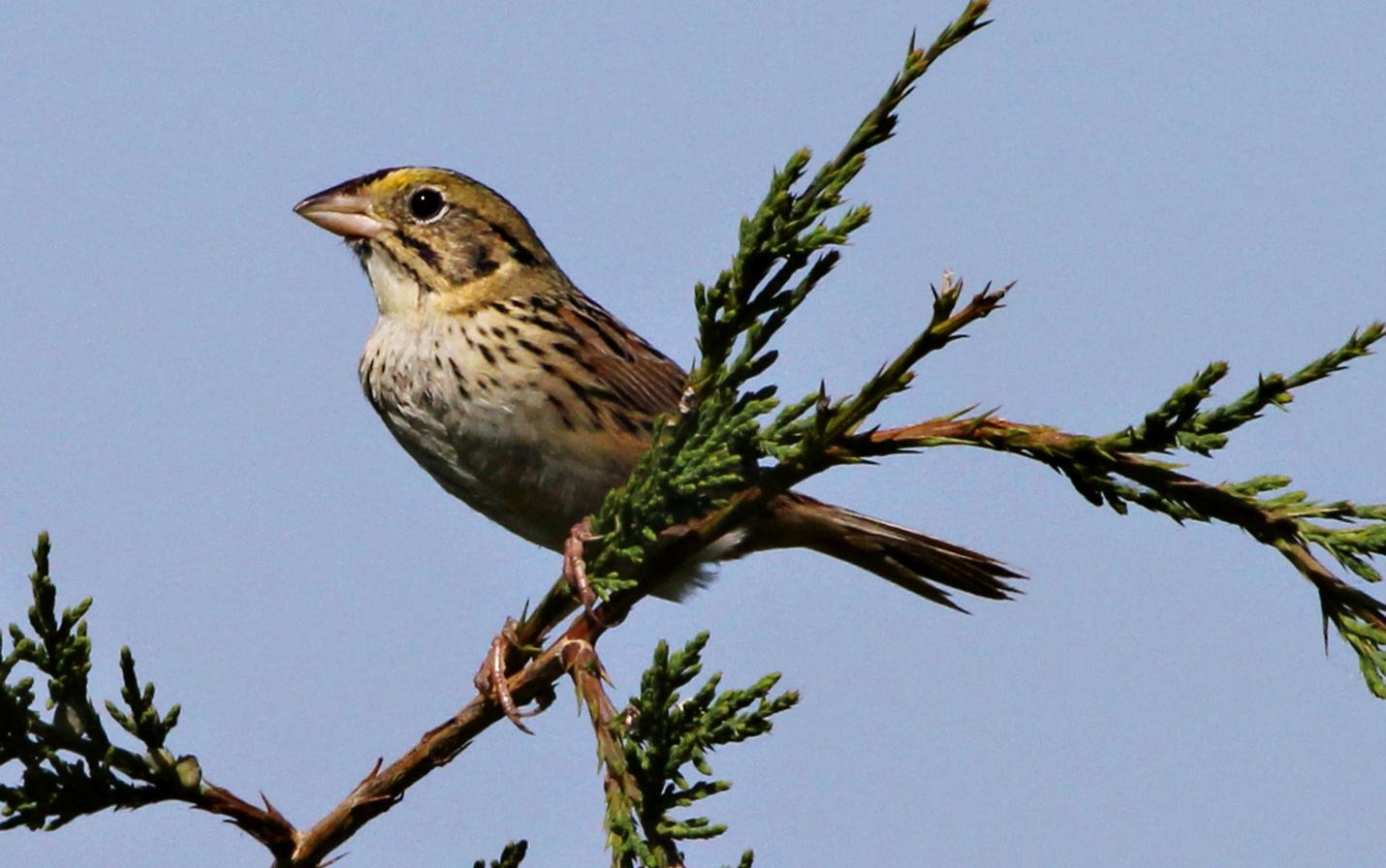
Surrounded by development, Mississippi Valley Conservancy’s 310-acre New Amsterdam Grasslands nature preserve provides critical habitat for rare ground-nesting birds and other wildlife. Each spring and summer, the fields of New Amsterdam Grasslands come alive with more than prairie blooms and rustling grasses—they sing. Those songs—of clay-colored sparrows, Bell’s vireos, meadowlarks, and sedge wrens—are more than beautiful; they are data points in a long-term story of land, resilience, and restoration.
(Photo above: Henslow's sparrow by Gwyn Calvetti)
As the 2025 bird survey concludes, the results highlight both the challenges grassland birds face and the value of careful conservation planning, volunteer support, and adaptive management. Since 2001, volunteers have been documenting bird species across the preserve, one of the first properties protected by the Conservancy. What began with volunteer Jean Ruhser, and later Kathy Carlyle, is now carried forward by Conservancy board member and survey volunteer Rob Tyser. Their standardized survey methods have created one of the longest-running local bird monitoring datasets in western Wisconsin.
“Because of its great agricultural value, tallgrass prairie is perhaps the most endangered habitat type in North America, so it’s a bit amazing that MVC has managed to protect this 300+ acre grassland,” said Tyser. “I’m grateful that this habitat will be available for grassland plants and animals to use in perpetuity.”
This year’s survey revealed mixed results. Many grassland species, such as the once-abundant Henslow’s sparrows and savanna sparrows, have declined from earlier peaks, likely due to shrinking migratory stopover and wintering habitat as well as local vegetation changes. As planted native prairie species have matured and replaced agricultural grasses, taller and denser vegetation has made the habitat less suitable for certain ground-nesting birds. Still, species like the state-threatened Henslow’s sparrow typically show greater nesting density in native prairie.
Meanwhile, the clay-colored sparrow—still the most frequently observed species—remains in good numbers, though gradually declining since its peak in the mid-2010s. “New Amsterdam Grasslands is the last large block of grassland left in the highly developed La Crosse area,” said Levi Plath, land manager for the Conservancy. “Despite our best efforts, many grassland birds are still declining—making places like this more important than ever for their survival.”
There are bright spots as well. Bell’s vireo, a species of high conservation concern, has been increasing steadily, alongside other shrub-loving species like field sparrows, brown thrashers, and willow flycatchers. These gains validate a key component of the management plan: maintaining a mosaic of grassland and shrubby habitat, especially along historic fence lines and near brushy areas adjacent to Highway 53.
“Bell’s vireo like clumps of thick brush, especially overgrown with vines,” said site steward Pat Caffrey. “We mow rather than burn to control expanding brush around the patches, keeping a ‘green edge’ that helps hide nests. People often see the strange mowing patterns along Hwy 53 and wonder why we do that—but those patterns create exactly the habitat that Bell’s vireo need.”

Behind these strategies are dedicated site stewards like Caffrey, who serve as the Conservancy’s “boots on the ground.” Caffrey’s knowledge and ongoing attention to how birds and vegetation respond make him an essential part of turning science-based management plans into meaningful conservation outcomes.
Looking ahead, management at New Amsterdam Grasslands will continue to balance the needs of brush-dependent species with open grassland species through:
• Prescribed fire and property-wide mowing to reduce woody encroachment and to maintain grassland structure (for species like grasshopper sparrows and sedge wrens) while maintaining areas with more than two years of thatch for Henslow's sparrow nesting;
• Monitoring predator presence (like domestic cats or dogs) that could threaten ground-nesting birds;
• Enhanced partnerships with neighboring landowners and organizations to advocate for grassland-friendly practices beyond the preserve's borders, supporting birds that migrate and overwinter far from Wisconsin.
“The heart and soul of this organization is about the long-term conservation of plants and animals,” said Tyser. “The Conservancy is a science-based organization, and its practices seek to be informed by useful conservation data. I like being able to provide some of this data.” Every bird counted and every trend identified underscores the importance of patience, persistence, and people who care deeply about conservation. Thanks to the foresight of its founders and the dedication of its supporters, New Amsterdam Grasslands continues to serve as both a haven for birds and a living laboratory of learning.
We invite supporters and the public to be part of this work. Volunteer work parties are scheduled throughout the year, and financial support helps support the staff time and equipment needed to manage the land. With continued volunteer help and donations, the Conservancy can protect more places like New Amsterdam Grasslands, restore more habitat, and ensure that when birds thrive, we all do. We hope you will join us at future work parties at one of our 30+ nature preserves in the near future!